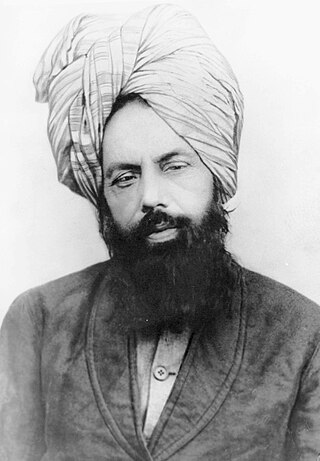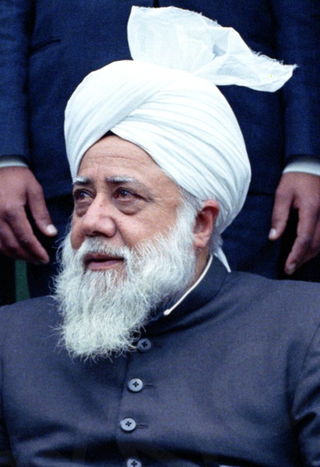Qadiani or Qadiyani is a religious slur used to refer to Ahmadi Muslims, primarily in Pakistan. The term originates from Qadian, a small town in northern India, the birthplace of Mirza Ghulam Ahmad, the founder of the Ahmadiyya movement. While it is pejorative to the Ahmadiyya Muslim Community, it is used in official Pakistani documents.

MirzāGhulām Aḥmad was an Indian religious leader and the founder of the Ahmadiyya Movement in Islam. He claimed to have been divinely appointed as the promised Messiah and Mahdī—which is the metaphorical second-coming of Jesus (mathīl-iʿIsā), in fulfillment of the Islamic prophecies regarding the end times, as well as the Mujaddid of the 14th Islamic century.

The Lahore Ahmadiyya Movement for the Propagation of Islam, is a separatist group within the Ahmadiyya movement that formed in 1914 as a result of ideological and administrative differences following the demise of Hakim Nur-ud-Din, the first Caliph after Mirza Ghulam Ahmad. Members of the Lahore Ahmadiyya movement are referred to by the majority group as ghayr mubāyi'īn and are also known colloquially as Lahori Ahmadis.

Qadian is a city and a municipal council in Gurdaspur district, north-east of Amritsar, situated 18 kilometres (11 mi) north-east of Batala city in the state of Punjab, India. Qadian is the birthplace of Mirza Ghulam Ahmad, the founder of the Ahmadiyya movement within Islam. It remained the headquarters of the Ahmadiyya movement until the Partition of India in 1947.

Mirza Nasir Ahmad was the third Caliph of the Ahmadiyya Muslim Community. He was elected as the third successor of Mirza Ghulam Ahmad on 8 November 1965, the day after the death of his predecessor and father, Mirza Basheer-ud-Din Mahmood Ahmad.

Mirza Basheer-ud-Din Mahmood Ahmad was the second caliph, leader of the worldwide Ahmadiyya Muslim Community and the eldest son of Mirza Ghulam Ahmad from his second wife, Nusrat Jahan Begum. He was elected as the second successor of Mirza Ghulam Ahmad on 14 March 1914 at the age of 25, the day after the death of his predecessor Hakim Nur-ud-Din.

Hakeem Noor-ud-Din was a close companion of Mirza Ghulam Ahmad, the founder of the Ahmadiyya Movement, and his first successor and first Ahmadiyya caliph since 27 May 1908.

The Ahmadiyya branch of Islam has been subjected to various forms of religious persecution and discrimination since the movement's inception in 1889. The Ahmadiyya Muslim movement emerged within the Sunni tradition of Islam and its adherents believe in all of the five pillars and all of the articles of faith required of Muslims. Ahmadis are considered non-Muslims by many mainstream Muslims since they consider Mirza Ghulam Ahmad, the founder of the movement, to be the promised Mahdi and Messiah awaited by the Muslims.

Sayyad Abdul Latif more commonly known as Sahibzada Abdul Latif among the Ahmadiyya Movement in Islam, was the Royal Advisor to Abdur Rahman Khan and Habibullah Khan, the father and son kings of Afghanistan between the late 19th century and early 20th century. It is believed that Abdul Latif helped King Abdur Rahman Khan during the negotiation of the Durand Line Agreement with the British India in 1893. In 1902 he became a follower of Mirza Ghulam Ahmad and is remembered as one of the first martyrs of the Ahmadiyya movement.

Ahmadiyya, officially the Ahmadiyya Muslim Community or the Ahmadiyya Muslim Jama'at, is an Islamic revival or messianic movement originating in Punjab, British India, in the late 19th century. It was founded by Mirza Ghulam Ahmad (1835–1908), who claimed to have been divinely appointed as both the Promised Mahdi and Messiah expected by Muslims to appear towards the end times and bring about, by peaceful means, the final triumph of Islam; as well as to embody, in this capacity, the expected eschatological figure of other major religious traditions. Adherents of the Ahmadiyya—a term adopted expressly in reference to Muhammad's alternative name Aḥmad—are known as Ahmadi Muslims or simply Ahmadis.

The Review of Religions is an English-language comparative religious magazine published monthly by the Ahmadiyya Muslim Community. Regularly in print since 1902, it is one of the longest running Islamic periodicals in English. It has been described as the main publication of the Ahmadiyya movement in the language and as a valuable source material for information on the geographical expansion of Ahmadi activity. The magazine was launched by Mirza Ghulam Ahmad with the aim of conveying an accurate understanding of Islamic teachings across the English-speaking world and dispelling misconceptions held against the faith. The articles, however, typically comprise distinctly Ahmadi perspectives. In addition to the English edition published from London, the magazine currently publishes separate quarterly editions in German, French and Spanish.
Bahishti Maqbara, located originally in Qadian, India, and then in Rabwah, Pakistan, is a religious cemetery established by the Ahmadiyya Community as a directive from the community's founder Mirza Ghulam Ahmad, made known in his booklet Al-Wasiyyat. Mirza Ghulam Ahmad established it in his will after he saw an angel showing him the place of his burial.
Mirza Ghulam Murtaza was an Indian chief and landowner best known for being the father of Mirza Ghulam Ahmad, the founder of the Ahmadiyya movement. He belonged to a family of Mughal nobility that had lost most of its estates to the Sikh Kingdom during the late 18th century and only a fraction of which – including Qadian, the family's ancestral seat – he was able to regain from it.
Mirza Hadi Beg was an Indian nobleman and Qadi of Central Asian origin and a direct ancestor of Mirza Ghulam Ahmad the founder of the Ahmadiyya movement. He migrated from Samarqand, in what is today Uzbekistan, to northern India and settled in the Punjab during the 16th century. Hadi Beg was a collateral kin of Babur, the founding emperor of the Mughal dynasty in the Indian subcontinent, but was not a Timurid.
The word Mirzai is a religious slur used to refer to Ahmadis by many South Asian Muslims, primarily in Pakistan where they have been persecuted from early days and specially after the passage of Second Amendment to the Constitution of Pakistan which declares that Ahmadia are not Muslims and Ordinance XX. Ahmadis are the followers of Mirza Ghulam Ahmad of Qadian.

The Ahmadiyya branch in Islam has relationships with a number of other religions. Ahmadiyya consider themselves to be Muslim, but are not regarded as Muslim by mainstream Islam. Mainstream Muslim branches refer to the Ahmadiyya branch by the religious slur Qadiani, and to their beliefs as Qadianism a name based on Qadian, the small town in India's Punjab region where the founder of Ahmadiyya, Mirza Ghulam Ahmad was born.

Ahmadiyya is a persecuted branch of Islam in Saudi Arabia. Although there are many foreign workers and Saudi citizens belonging to the Ahmadiyya movement in Saudi Arabia, Ahmadis are officially banned from entering the country and from performing the pilgrimage to Mecca and Medina. This has led to criticisms from multiple human rights organizations.

Ahmadiyya is an Islamic movement in Australia, first formally founded in the country in the 1980s, during the era of the fourth caliph. However, the history of the Community dates back to the early 20th century, during the lifetime of the founder of the movement, Mirza Ghulam Ahmad, with the first contacts arising as a consequence of Australians travelling to British India, and also as a consequence of early, "Afghan" camel drivers settling in Australia during the mid to late 19th century. Today there are at least four Ahmadi mosques in four of the six Australian states, representing an estimated 6,000-8,000 Australian Ahmadis in the country.

Ahmadiyya is an Islamic religious movement in Syria under the spiritual leadership of the caliph in London.

The Ahmadiyya is an Islamic movement in Egypt with origins in the Indian subcontinent. Although the earliest contact between Egyptians and the Ahmadiyya movement was during the lifetime of Mirza Ghulam Ahmad, its founder, the movement in Egypt was formally established in 1922 under the leadership of its second Caliph Opposition to the Ahmadiyya grew particularly in the latter part the 20th century and Ahmadis have seen increased hostility in Egypt more recently. There are up to 50,000 Ahmadi Muslims in Egypt. Although the group is not officially recognised by the state.











